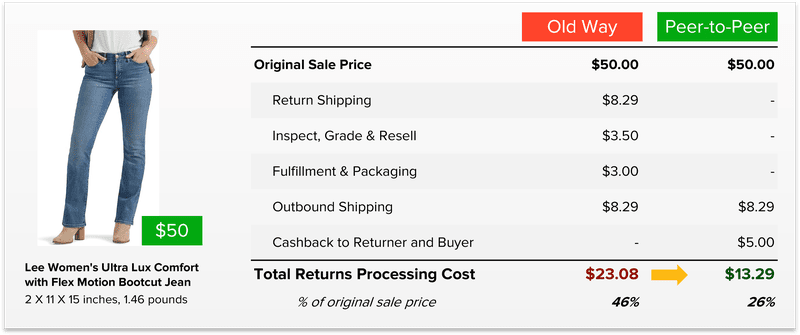Encouraging Customer Loyalty with an Exceptional Returns Program

Last updated on February 24, 2025

In this article
 12 minutes
12 minutes
- What is a Returns Policy?
- Understanding the Importance of a Returns Program
- Create a Clear, Customer-Friendly Return Policy
- Benefits of a Customer-Centric Returns Program
- Building a VIP Loyalty Program Around Returns
- Incentivize Exchanges Over Refunds
- Process Customer Returns Quickly via Automation
- Collect Customer Feedback to Improve Customer Satisfaction
- Clearly Display Returns Policy for Customer Ease of Access
- Summary
- Frequently Asked Questions
In the highly competitive world of ecommerce, delivering an exceptional customer experience is the key to fostering long-term loyalty. While much focus is placed on the initial purchase journey, the often-overlooked return process can make or break a customer’s relationship with a brand. While many ecommerce businesses view returns as a painful but necessary evil, forward-thinking retailers are discovering their untapped potential for building customer loyalty. In today’s competitive marketplace, a positive returns experience can transform one-time shoppers into lifelong brand advocates, driving sustained growth and profitability.
The challenge lies in meeting the lofty expectations set by industry giants. Shoppers today demand frictionless, convenient returns, with 76% of consumers considering free returns a crucial factor in their purchasing decisions. Brands that fail to deliver on this expectation risk severe consequences, as 89% of customers are less likely to buy from a retailer after a poor returns experience. Conversely, those who prioritize seamless returns can reap significant benefits, with 97% of shoppers saying they’d buy again from a brand that offers a positive returns process.
The evolution of ecommerce has led to a rise of return rates (particularly in the fashion industry, where some apparel brands experience return rates as high as 40%!), has dramatically shifted customer expectations around returns. Modern shoppers demand easy, quick, and convenient return processes. Indeed, they demand flexibility and transparency throughout the entire purchase lifecycle – which includes returns and clear return and refund policies.
What is a Returns Policy?
A returns policy is a set of rules that outlines the conditions under which customers can return purchases. It provides details on how and when a return can be made, whether customers will receive a refund, exchange, or store credit, and any other necessary requirements. For online sellers, a clear and fair returns policy can help build customer trust, reduce disputes, and improve overall customer satisfaction.
Key Return Policy Terms
- Return: When a customer sends back an item they purchased, whether due to defects, dissatisfaction, or other reasons.
- Refund: The process of reimbursing the customer for the returned product. Refunds can be issued via the original payment method, store credit, or alternative methods.
- Exchange: When a returned item is replaced with another of equal value, whether it be the same product (e.g., a different size or color) or a different product entirely.
Common Return Policy Elements
- Time Frame:
The number of days customers have to return an item. This period typically ranges from 15 to 30 days but may extend up to 90 days for certain products or special occasions. - Refund Information:
How customers will receive their refund, whether through their original payment method, store credit, or another method. - Customer Support:
Contact details for customer service, including email, phone, or live chat, so customers can get assistance with returns. - Return Instructions:
Step-by-step guidelines on how customers should return an item, including options such as mailing it back, returning it in-store, or using a drop-off location. - Condition of Returned Items:
Any conditions regarding the state of the product being returned, such as whether it must be unused, in original packaging, or accompanied by a receipt. Return policies often have specific rules on damages for items. - Return Shipping and Restocking Fees:
If applicable, any fees customers may be required to pay for returning an item. - Exceptions and Restrictions:
Details on which products are not eligible for return, such as final sale items, perishable goods, or digital downloads.
Legal Considerations
- Compliance with Consumer Protection Laws:
Online sellers must comply with regional and international laws related to consumer rights, such as the U.S. FTC regulations, EU Consumer Rights Directive, or other applicable legislation. - Refund Processing Time:
Some jurisdictions require refunds to be processed within a certain number of days after receiving a returned product. - Transparency in Policy Terms:
Sellers must be upfront about any conditions, fees, or exceptions to avoid misleading customers and potential legal disputes. - Privacy of Customer Data:
Ensure that any customer data collected during the return process is handled in compliance with data protection laws such as GDPR or CCPA.
Return Policy Best Practices for Online Sellers
- Ensure Accessibility:
The return policy should be easy to find on the website, preferably linked in the footer, checkout page, and product descriptions. - Offer Free Return Shipping:
Consider covering the cost of return shipping, especially during the holiday season, to encourage customer confidence and repeat business. - Provide a Hassle-Free Process:
Simplify the return steps to enhance the customer experience and reduce friction. - Use Clear and Simple Language:
Avoid complex legal jargon so that customers can easily understand their rights and responsibilities. - Request Customer Feedback:
Collect feedback from customers on their return experiences to identify areas for improvement. - Analyze Return Data:
Track return reasons and trends to make adjustments to product quality, descriptions, and return policies as needed. - Mitigate Return Fraud:
Return Fraud is an inescapable part of providing returns, but the benefits of providing online returns can be maintained while still protecting against fraud.
A well-crafted return policy not only protects the business but also fosters customer loyalty by demonstrating fairness and transparency.
Understanding the Importance of a Returns Program
An effective and efficient returns program is a cornerstone of any successful online business; directly influencing customer satisfaction and reinforcing loyalty. When customers know they can return or exchange items with ease, it transforms potential frustration into a positive experience, encouraging repeat purchases and strengthening brand trust. This sense of security and flexibility is crucial in today’s competitive market, where customer expectations are higher than ever.
A poorly managed returns program can severely damage customer loyalty. When customers encounter difficulties returning or exchanging items, frustration and distrust can quickly set in. This negative experience can lead to unfavorable reviews, a decline in repeat business, and ultimately, a loss of customer loyalty.
Sustainability and Eco-Friendly Return Interest Rising
In addition, customers are becoming increasingly environmentally conscious; sustainability and environmental impact are becoming a deciding factor for more and more customers. Including sustainability into a returns program can capture this market segment’s interest and loyalty.
Create a Clear, Customer-Friendly Return Policy
Transparency is crucial when it comes to building trust and confidence. Make sure the refund policy is prominently displayed, written in plain language, and covers all the key details upfront. Having a purchase receipt is essential for returns, as it determines eligibility and the return window. Refunds will be processed back to the original payment method. Spell out exactly what’s eligible for return, the timeframe, any fees, and the available resolution options like refunds, exchanges, or store credit.
Different research studies report that between 60% and 80% of customers check the return policy before making a purchase. So a clear, easy-to-understand policy can be the difference between a lost sale and a prospective loyal customer. Setting reasonable expectations and making the process seamless will encourage shoppers to buy, knowing they can return items hassle-free. And remember, most online shoppers consider free returns a crucial factor in their purchasing decisions.
Benefits of a Customer-Centric Returns Program
Implementing a customer-centric returns program offers numerous advantages. These benefits include:
Offer Flexible Return Methods with Free Return Shipping
Convenience is king, especially when it comes to returns, and especially for those that spend the most online (30 – 60-year-olds). Items purchased with gift receipts often have more lenient return policies. For example, not all customers have easy access to packing materials or printers, so providing flexible return options – like including pre-paid labels with the purchase or offering boxless drop-off locations (aka ‘return bars’) – will ensure a seamless experience by meeting the customer where they are.
Generous policies play a crucial role in building trust and fostering long-term relationships. Extended returns windows, (even if only for unopened or unused items), signals to customers that their business is a top priority. Catering to different customer preferences, demonstrates commitment to the customer relationship, increasing the chances they’ll shop again in the future. Empowering shoppers to make informed decisions up front has also been shown to encourage larger purchases, more frequent shopping, and increased recommendations.
Building a VIP Loyalty Program Around Returns
If returns are just too expensive in categories with razor-thin margins, consider offering a loyalty program that caters specifically to the needs of high-value customers. By offering VIPs enhanced returns benefits such as free return shipping, expedited processing, or extended return windows, brands can demonstrate their commitment to their satisfaction, deepening their loyalty and encouraging them to shop more frequently, a point which is frequently confirmed by respondents in research studies. Such a VIP program helps build a moat around the returns process to prevent return scammers from abusing returns.
Incentivize Exchanges Over Refunds
While refunds are sometimes unavoidable, savvy retailers can leverage exchanges as a powerful tool for retaining revenue and strengthening customer bonds. Restocking fees can significantly impact the profitability of returns, making it crucial to manage these costs effectively. By incentivizing exchanges through exclusive discounts, coupons, free shipping, or even offering the option to exchange for a more expensive item, companies can encourage shoppers to stay within their ecosystem, transforming potential lost sales into loyal, repeat customers. Nearly all respondents across research studies say they’ll buy again if the returns experience is easy.
Process Customer Returns Quickly via Automation
Time is of the essence when it comes to returns. Speedily handling returns not only helps with customer satisfaction, but also brings inventory back into a sellable state as soon as possible.
Implementing an automated returns management system is perhaps the most impactful step brands can take to improve both the customer experience and inventory processing of returns. Clear return and refund policies are crucial in such a system, as they streamline the return process and enhance customer satisfaction. By streamlining the returns workflow through self-service portals, eligibility rules, and seamless integrations, businesses can resolve requests quickly and accurately – freeing up time to focus on higher-value tasks.
Efficient returns handling not only prevents customers from becoming frustrated, but more than half of customers say they’d be willing to spend more if they knew their refund would be processed quickly. Streamlining the returns workflow through automation can drastically reduce wait times, building trust and loyalty in the process.
Once returns arrive in the warehouse, automation also helps to streamline the receiving workflow to match the item to the customer’s order and bring the inventory back into the system for resale.
Collect Customer Feedback to Improve Customer Satisfaction
Regularly gathering data and feedback on returns and the returns process is crucial for continual improvement and reducing the cost of returns. Track key metrics like return rates, reasons for returns, along with customer satisfaction scores, to identify trends and pinpoint areas for optimization. This data-driven approach allows sellers to address pain points, fix underlying issues (which lowers cost), and tailor the returns experience to the customers’ evolving needs. By continuously improving the process based on their input, customers will see their satisfaction is a top priority.
Clearly Display Returns Policy for Customer Ease of Access
Displaying returns policies clearly and prominently is essential for building trust and confidence with customers. Here are some effective strategies for making the site’s returns policy easily accessible:
Website or App Footer for Easy Access
One of the most effective places to display the returns policy is in the footer of the website or app. This ensures that customers can easily find and reference it at any time. Additionally, consider including links to the returns policy on product pages, during the checkout process, and within the customer account dashboard. By making the returns policy readily available, businesses demonstrate transparency and commitment to customer satisfaction.
Summary
The returns process is a critical touchpoint that can either strengthen or undermine customer loyalty. Return shipping costs significantly impact a business’s finances when customers opt for refunds instead of exchanges. By prioritizing transparency, flexibility, speed, and automation, businesses can transform this often-overlooked aspect of the customer journey into a strategic advantage that keeps shoppers coming back. Just look at the success stories. It’s not hard to find companies that reduced their return rate from 15% to 4% or converted 30% of returns into exchanges. When the returns experience is seamless, customers are more likely to remain loyal, make repeat purchases, and even become brand advocates. It’s no secret that loyal customers are incredibly valuable.
So, don’t let returns be an afterthought. Embrace them as an opportunity to build trust, boost satisfaction, and cultivate a base of devoted, lifelong customers. They may be expensive in some cases, but they’re a part of doing business. And by investing in the returns process with a clear policy and convenient options presented to the customer, it becomes a differentiator, and brands will position themselves as industry leaders in customer satisfaction, which encourages loyalty and attracts new business.
Frequently Asked Questions
What is a Return Policy?
A return policy is a store’s rules on how customers can return unwanted or problematic products. Return policies can allow for refunds (either for cash or store credit), exchanges (the same item, or upsells), or both. There are usually time limits or specific product warranties, and often exceptions based on the kind of goods sold.
Do I Need a Return Policy?
In the US, consumer protection laws require retailers to uphold sales promises, which includes any return policy specified. However, not all states require a return policy for online retailers. Having a clear and easily accessible return policy helps prevent any ambiguity.

Up to 64% Lower Returns Processing Cost


